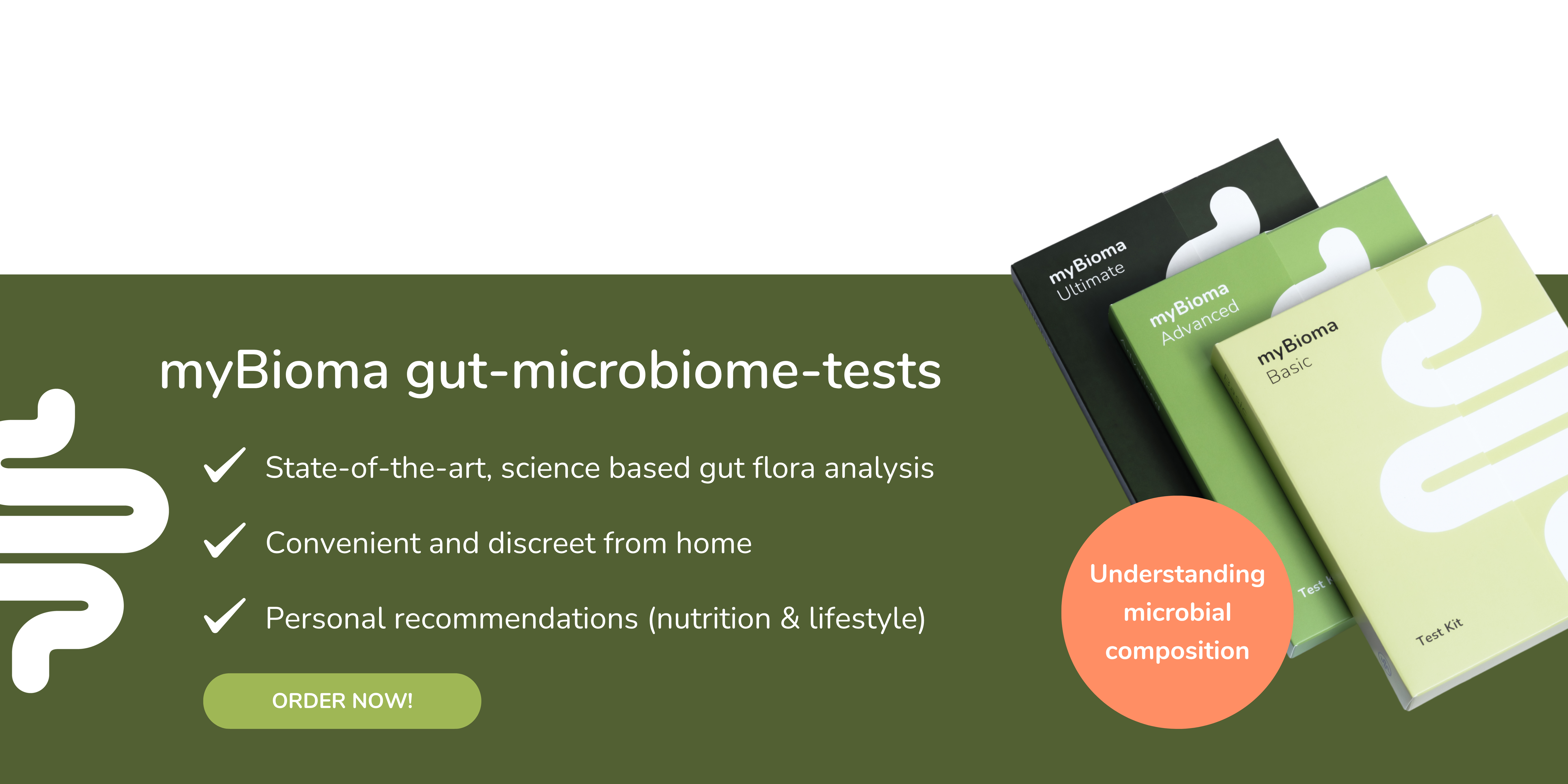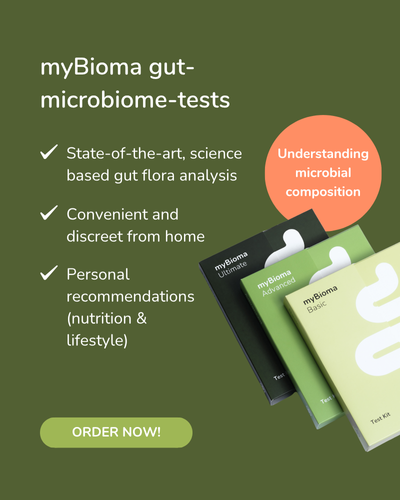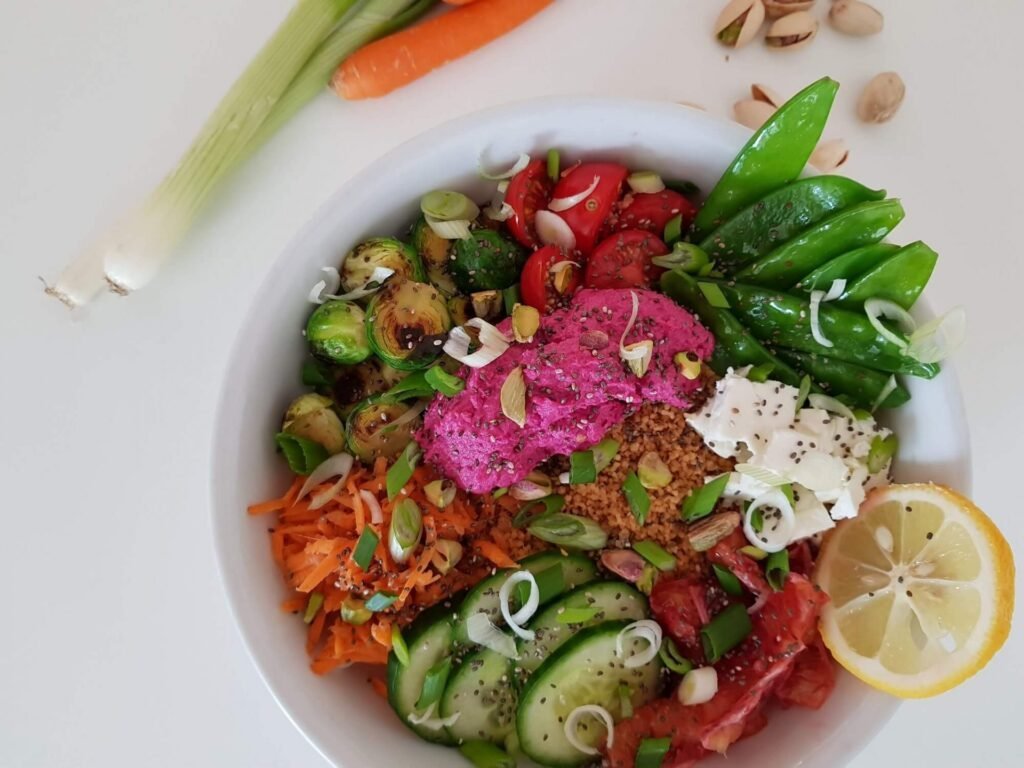Table of contents
- Why protein is essential for our body
- How proteins are digested
- Protein & microbiome: important connections explained
- Animal protein vs. plant protein – which is better?
- The best protein sources
- How much protein do we need?
- How much protein is too much?
- Tips for gut-friendly protein intake
- A closer look at protein trends
- Why a healthy microbiome is important for muscle growth
- Conclusion: Protein & fibre are a dream team for your gut
Proteins are truly multitalented: They keep us full, control countless metabolic processes, and provide the building blocks for muscles, hormones, enzymes, and immune cells. Without sufficient protein, our bodies wouldn't function properly.
While a high-protein diet is particularly popular in the fitness world, there are also repeated warnings about the negative effects of too much protein. To understand how protein works, it's worth taking a look at our gut—more specifically, at the gut microbiome. This is where we determine whether protein strengthens us or, in excess, is detrimental.
In this article, you'll learn, among other things, how proteins are digested, what influence they have on our microbiome, and what you should pay attention to in your diet to support not only muscle growth but also your gut health.
Why protein is essential for our body
Amino acids: The building blocks of life
Proteins consist of long chains of amino acids. These building blocks play a role in almost all processes in our body and perform key functions, including:
- Wound healing: Proteins support the formation of new tissue and thus accelerate regeneration after injuries or operations.
- Immune defense: Antibodies and immune cells need protein to protect our body.
- Signal transmission: Hormones like insulin and neurotransmitters like serotonin are derived from amino acids. They influence important metabolic processes and the nervous system.
- Energy source: When carbohydrates and fats are scarce, amino acids can be converted into energy – important in stressful situations or when fasting.
- Transport & Storage: Proteins transport nutrients in the blood, store iron (ferritin) and bind oxygen (hemoglobin).
- Structure & Stability: Collagen and keratin are important structural proteins that ensure healthy skin, hair, nails, bones and connective tissue.
- Muscle building & recovery: Sufficient protein is essential for building and maintaining muscle mass and is important for recovery after training.
- Intestinal health: Certain amino acids such as glutamine serve as an energy source for the cells of the intestinal mucosa and support the stability of the intestinal barrier.
Proteins: Quality over quantity
The body can synthesise some amino acids on its own, while others – the so-called essential amino acids – must be obtained from food. Different foods supply these amino acids in varying amounts. Protein quality is primarily judged by its amino acid profile: a protein is considered complete if it provides all nine essential amino acids in adequate amounts.
- Animal proteins (e.g. meat, fish, eggs, dairy products) are generally considered complete because they have an optimal amino acid profile and are particularly well absorbed by the body.
- Plant proteins (e.g., legumes, nuts, seeds, grains) are often considered incomplete because they lack one or more essential amino acids in sufficient quantities. Nevertheless, they have several advantages: They provide fibre, phytochemicals, and have a positive effect on the intestinal flora.
- Combinations of plant protein sources (e.g. beans with rice or hummus on whole-grain bread) complement each other to create a complete amino acid profile.
Bioavailability – that is, how efficiently our body can absorb amino acids – is also crucial. It can be affected by food processing: for example, sprouting or heating can alter protein structures, making them easier to digest and absorb. Conversely, certain naturally occurring compounds can hinder protein utilisation and reduce absorption. These include tannins, which are found in grains and legumes (1). More on this later.
Conclusion: A balanced mix of animal and plant sources meets your protein needs while also supporting gut health.
How proteins are digested
For our body to utilize proteins, they must first be digested. In the stomach and small intestine, certain enzymes break proteins down into smaller fragments: peptides and their smallest form, amino acids. The majority of these fragments, approximately 90%, are absorbed into the bloodstream in the small intestine.
A small residue remains undigested and reaches the large intestine. There, the protein residues encounter the billions of bacteria in our gut microbiome. And this is where things get interesting: Depending on the amount, source, and accompanying substances, the peptides and amino acids are converted by our gut bacteria into either beneficial or harmful metabolites (2).
Note: The gut microbiome refers to the community of countless microorganisms (primarily bacteria) that have a significant impact on our health and well-being. They influence not only digestion and metabolism, but also our immune system, our mental well-being, and our skin health, among other things.
Protein & microbiome: important connections explained
The main food source of our tiny intestinal companions is not actually protein, but fibre. They break it down into short-chain fatty acids (SCFAs) such as butyrate, acetate, and propionate, which have numerous positive effects on our (gut) health.
Certain bacteria can also produce short-chain fatty acids and other beneficial metabolites from proteins, or more specifically from nitrogen and amino acids. However, potentially harmful substances can also be formed. This largely depends on the type and amount of amino acids – as well as the composition of the microbiome, that is, the bacteria present in the gut.
Certain bacteria, such as bifidobacteria and lactobacilli, prefer to feed on prebiotic fibre, which is found in foods like onions, barley, bananas, cooled potatoes, or asparagus. Proteins, on the other hand, are more likely to be digested by bacteria such as Bacteroides and Clostridia. These bacteria are also called proteolytic, meaning protein-degrading bacteria.
If we consume too much protein and too little fibre, these protein-degrading bacteria can take over and crowd out other beneficial bacteria. The delicate balance in the microbiome is disrupted, and fewer anti-inflammatory, short-chain fatty acids are produced (2,3).
Side note: Every bacterium has its favorite food, which is why it's best to eat as varied a diet as possible. This ensures that as many different bacteria as possible are nourished and can perform their various tasks for us as best as possible.
Adequate protein intake is extremely important for gut health – but too much protein can also be harmful.
Positive effects of protein on the gut
- Energy for intestinal cells: Amino acids such as glutamine and aspartate are fuel for the intestinal mucosa and support its regeneration.
- Signaling effect: Amino acids act like messengers, helping the digestive tract “sense” nutrients and regulate digestion optimally.
- Building material for microbes: Intestinal bacteria use amino acids not only as an energy source, but also to build their own structures.
- Useful metabolic products: With a balanced protein intake, metabolic products such as certain short-chain fatty acids can be produced, which strengthen our gut barrier.
- Fibre bonus: Plant protein sources such as legumes provide additional fibre – a combination that promotes, for example, bifidobacteria and roseburia, both known for positive effects on intestinal health (4).

Sufficient protein not only supports our physical fitness, but also our gut microbiome and our immune system.
Potentially harmful effects of protein on the gut
If you eat more protein than necessary, the excess passes undigested into the large intestine. In particular, amino acids from animal protein sources, such as methionine, cysteine, tryptophan, tyrosine, or phenylalanine, can have negative effects on our intestinal health (2, 4, 5):
- Unfavorable metabolic products: Excess protein in the large intestine can lead to the formation of ammonia, indoles, or sulfur compounds – in high amounts, these can irritate the intestinal lining and cause digestive issues.
- Risk of inflammation: Those degradation products weaken the intestinal barrier and thus promote inflammatory processes.
- Microbial imbalance: A high-protein, low-fibre diet can lead to reduced microbial diversity and disrupt the balance of gut bacteria.
- Long-term consequences: A sustained excess of animal protein, without balancing fibre, is associated with a higher risk of intestinal diseases and even colon cancer.
Animal protein vs. plant protein – which is better?
Benefits and possible risks of animal protein sources
Meat, fish, eggs, and dairy products are great sources of protein, as they provide all essential amino acids in optimal ratios – meaning our body can absorb and utilize them ideally.
However, a high intake of animal protein can lead to problematic bacterial metabolites and negatively affect the composition of the microbiome.
Other components of animal protein sources – particularly red or processed meat – such as L-carnitine and choline, can also have negative effects on health when consumed in large amounts. The gut microbiome converts them into trimethylamine (TMA), which is then oxidised to TMAO in the liver. This enters the bloodstream and is closely associated with an increased risk of cardiovascular disease (2,6)

When we consume large amounts of animal protein – especially from red meat – while eating too little fibre, certain gut bacteria increasingly produce potentially harmful metabolites.
Plant proteins as a booster for gut health
Pulses, nuts, seeds and whole grain products offer several benefits:
- They contain protein and fibre and thus promote the production of valuable short-chain fatty acids.
- They increase microbial diversity – one of the most important markers of a healthy microbiome.
- They provide phytochemicals that also have an anti-inflammatory effect.
Several studies suggest that plant proteins can support intestinal health – mainly due to their natural combination with fibre and their anti-inflammatory properties (4).
Antinutrients in plants: cause for concern?
So-called antinutrients such as phytic acid, oxalates, or lectins occur naturally in many plant protein sources such as legumes, grains, nuts, or seeds. They can slightly reduce the absorption of certain minerals and protein availability. However, this is generally not a problem, as most of these substances are significantly reduced by cooking. Antinutritional factors in legumes and grains can be reduced even more effectively by soaking legumes before cooking, sprouting grains, or using fermentation (for example, in tofu, tempeh, or sourdough bread), so that they have little impact on nutrient availability. Interestingly, some antinutrients can even have beneficial effects in small amounts, such as helping to regulate blood sugar or cholesterol levels (7).
However, we recommend that people with increased protein needs or iron deficiency, for example, also include animal protein sources. A varied and balanced diet benefits our body on all levels.
Conclusion: Balance is key & diversity wins
Animal proteins also offer benefits for gut health – for example, dairy products, which can contain probiotic cultures. The key is balance: a mix of high-quality animal proteins and diverse plant-based sources that also provide fibre.
The best protein sources
- Lean meats such as chicken and turkey breast provide high-quality protein as well as important nutrients such as iron and zinc.
- Fish not only provides plenty of protein, but also often contains valuable omega-3 fatty acids, which are good for heart health. Be sure to pay attention to quality and sustainable fish farming.
- Milk and dairy products like cheese and yogurt contain plenty of protein, calcium, and other important nutrients. Low-fat products like skyr, cottage cheese, and low-fat quark are among the best dairy protein sources.
- Eggs contain all essential amino acids and are an easily digestible, complete source of protein. They also provide vitamins, minerals, healthy fats, and antioxidants.
- Pulses such as beans, peas, and lentils are excellent sources of protein and also provide fibre, folic acid, potassium, iron, and zinc. Thanks to their high lysine content, they ideally complement the amino acid pattern of grains and grain products.
- Soy products such as tofu, tempeh and soy drinks contain all essential amino acids and are therefore particularly excellent sources of plant-based protein that can also be integrated into a wide variety of healthy dishes.
- Nuts and seeds such as almonds, hazelnuts, walnuts, peanuts, chia seeds, pumpkin seeds, sunflower seeds, hemp seeds, and peanuts (strictly speaking, peanuts are legumes) are little powerhouses that provide you with protein, healthy fats, vitamins, and minerals. Since nuts are high in calories and fat, it's a good idea to watch your portion size—we recommend about 2-3 tablespoons per day.
- Quinoa and amaranth are plant-based protein sources that are also considered complete proteins and are rich in minerals and fibre. As pseudocereals, they are also naturally gluten-free.

Plant-based protein sources provide not only protein but also fibre – giving them a double benefit for health.
How much protein do we need?
Overall, consumption studies show that most people in Europe get more than enough protein – a deficiency is extremely rare. Those at risk include individuals who eat very selectively or follow highly restrictive diets, or who have certain chronic illnesses. Vegans should also pay attention to their protein intake – particularly to combining different plant-based sources throughout the day.
Protein requirements of adults
The German Nutrition Society (DGE) recommends an intake of 0.8 g of protein per kg of body weight for adults (8).
Example: For a person weighing 70 kg, the protein requirement is around 56 g.
This can be met with, for example:
- 60 g oat flakes (dry) → approx. 12 g protein
- 200 g potatoes + 100 g curd cheese → approx. 15 g protein
- 150 g cooked lentils → approx. 13 g protein
- 1 egg → approx. 6 g protein
- 2 slices of whole-grain bread with hummus → approx. 10 g protein
Everyday tip for implementation: By incorporating at least one protein-rich food into every meal, you can easily meet your protein needs – without the hassle of tracking. For example: yogurt and oatmeal for breakfast, tofu or chicken breast for lunch, lentil soup, eggs, or cottage cheese for dinner.
By the way: Having protein at every meal is also beneficial for our blood sugar! Learn more in this blog post: How your gut bacteria influence your blood sugar levels.
In cases of chronic or acute illnesses, inflammation, or injuries, protein requirements may be higher because the body needs extra support for repair processes. Protein needs can also change depending on life circumstances:
Protein requirements of older people, athletes and during pregnancy/breastfeeding
Increased protein intake is recommended for certain groups of people (8):
People aged 65 and older
- Estimated protein requirement: 1 – 1.2 g/kg body weight/day.
- With age, muscle mass naturally decreases (sarcopenia), and the risk of disease and inflammation increases. As a result, the body needs more protein for tissue repair, immune function, and healing. This is only an estimate—the need may be even higher in case of existing health conditions or limited mobility.
Athletes
- For recreational athletes (4–5 × 30 minutes/week, moderate intensity), 0.8 g protein/kg body weight per day is sufficient.
- Ambitious recreational or competitive athletes (≥5 hours/week) benefit from 1.2 - 2 g/kg body weight/day, adapted to the sport type, training goals and volume.
- Protein should be distributed across meals throughout the day. Supplements can be a convenient addition but are not essential and should never replace a balanced diet.
Pregnancy and breastfeeding:
- In the second trimester the requirement increases to 0.9 g/kg body weight and in the third trimester to 1 g/kg body weight.
- Breastfeeding women should consume approximately 1.2 g of protein per kg of body weight.
How much protein is too much?
There is currently no generally accepted upper limit for protein. This is because individual needs can vary greatly, and scientific data have not yet clearly established what amount of protein is truly "too much."
What we know for sure:
- The body cannot use excess protein efficiently (9).
- During degradation, metabolic products such as urea are produced, which must be excreted in the urine. Therefore, adequate fluid intake is very important in a high-protein diet (10).
Estimates from professional societies (10):
- Observations show that even a protein intake three to four times higher than the reference value is often possible over extended periods without noticeable side effects. However, the WHO emphasizes that this does not automatically mean that such high amounts are completely risk-free. Furthermore, the impact on the microbiome has not (yet) been taken into account.
- The EFSA (European Food Safety Authority) considers an intake of up to twice the reference value to be safe for healthy adults.
- Conclusion for implementation: For healthy adults, up to 2 g of protein per kilogram of body weight is generally considered unproblematic. According to current research, amounts above this do not provide any additional health benefits and should not be consumed on a daily basis.
Symptoms & risks of too much protein
Excessive protein intake can cause noticeable symptoms:
- Digestive problems: flatulence, diarrhea or constipation due to increased bacterial protein fermentation.
- Bad breath: Degradation products such as ammonia or ketone bodies can cause unpleasant bad breath.
- Dehydration: Increased urea production puts a strain on the kidneys and increases fluid requirements – this can manifest itself, for example, in increased thirst, dry mouth or headaches.
- Skin health: In particular, whey proteins from cow’s milk, with their branched-chain amino acids (BCAAs), can stimulate the sebaceous glands and may trigger or worsen acne. Additionally, protein-dependent metabolites can promote skin inflammation.
- Long-term risks: Kidney stones, elevated liver enzymes, and an increased risk of colorectal cancer and heart disease have been observed, particularly with diets high in red or processed meat. Important: In healthy individuals, the kidneys usually tolerate high protein intakes without problems. However, people with impaired kidney function should be cautious.
Tips for gut-friendly protein intake
- Prioritise plant-based protein sources to also obtain important fibre. For better digestibility, it is recommended to soak legumes overnight before cooking or to sprout grains.
- Mix protein sources throughout the day: e.g., lentil dal with rice, hummus on whole-grain bread – for a balanced amino acid profile.
- Quality over quantity: Avoid highly processed foods – many products that advertise high protein often contain many additives or sweeteners that are not beneficial for our gut microbiome.
- Fibre at every meal: Vegetables, fruit, whole grains, and legumes ensure balance in the microbiome and provide important vitamins and minerals.
- Fermented foods: Yogurt, kefir, or tempeh provide protein plus live bacteria to support our microbiome.
A closer look at protein trends
A clear nutritional trend in recent years has been the increasing consumption of high-protein products such as protein bars, protein pudding, protein coffee, protein powder or protein shakes.
An increased protein intake can certainly have advantages – for example, it ensures longer-lasting satiety, supports weight loss, helps with muscle maintenance and promotes muscle building during training.
But: More protein doesn't automatically mean more muscle. The body can't convert excess protein into muscle mass indefinitely. Instead, it's excreted, metabolized by bacteria in the gut, or converted into glucose and fat. The body either uses this energy directly or stores it as fat. If highly processed, high-protein foods become the basis of your diet, this can have negative consequences for your microbiome and overall health.
And your wallet can feel the impact too: Many food manufacturers capitalise on the high-protein trend, creating highly processed products from cheap ingredients that often cost more than standard alternatives.
When are foods considered high-protein?
According to the EU Food Information to Consumers Regulation, the following requirements apply to protein claims:
- “Protein source”: At least 12% of the total energy content comes from protein.
- “High Protein”: At least 20% of the total energy content comes from protein.
Example calculation for high protein pudding:
- Total energy: 80 kcal
- Protein content: 10 g protein × 4 kcal/g = 40 kcal from protein
- Protein content: 40 ÷ 80 = 50% → meets the “High Protein” requirement
Important: Always check the ingredients list. Most high-protein products contain additives such as emulsifiers or sweeteners, whose effects on the microbiome have not yet been sufficiently researched and are considered rather questionable.
Protein powder – useful or harmful?
Protein powders are generally a practical way to increase your daily protein intake. However, unlike protein-rich foods, they often lack the variety of nutrients, fibre, and phytochemicals that are so important for our health. Furthermore, many powders contain additives or sweeteners, or are contaminated with harmful substances such as heavy metals. So be sure to pay attention to the quality!
In general, protein requirements can be easily met with a balanced diet. In certain situations, protein powders can be a useful supplement. The most common protein supplements are based on milk protein:
- Whey protein: Fast absorption, rich in essential amino acids, known for its benefits for muscle building
- Casein: Slow absorption over several hours, ideal as a “night protein”
Both are of animal origin and unsuitable for people with lactose intolerance. Furthermore, some people report digestive discomfort or skin problems with high intake.
For plant-based protein powders, it is advisable to combine different sources. This improves the amino acid profile – because, with the exception of soy, plant proteins have a lower biological value than animal proteins. Possible sources include lupin protein, pea protein, soy protein, hemp protein, or rice protein – there is a wide selection. Potential drawbacks can include taste (which is subjective), lower protein content per 100 g (but more fibre and phytonutrients), and allergy potential (especially with soy).

If you want to use protein powder, pay attention to the ingredients list and choose protein sources that are as natural as possible, without additives or sweeteners.
Problematic: High Protein, Low Fibre
Many high-protein diets, such as the keto diet, focus on lots of meat, dairy products, and eggs. Carbohydrates are avoided—and thus, the intake of valuable fibre is also very low. Fibre fuels our microbiome and is linked to a lower risk of numerous chronic diseases such as cardiovascular disease, type 2 diabetes, and certain types of cancer (11).
Studies show that bodybuilders who consume a lot of protein but little fibre have a less diverse gut microbiota than those who get enough fibre. Low microbial diversity (bacterial variety) can lead to digestive issues and, in the long term, have a range of negative health effects.
Athletes who prioritise a protein-rich diet should therefore make sure to get the recommended amount of 14 g of fibre per 1000 kcal. You can find practical tips for putting this into practice in this blog article: Health benefits and tips for a high-fibre diet
Tip: Eating a high-fibre meal directly before or after training can trigger discomfort, so the timing of fibre intake is crucial.
Protein + fibre for muscle growth
As mentioned earlier, fibre is broken down in the gut by bacteria into short-chain fatty acids (SCFAs) such as butyrate, acetate, and propionate. These compounds are not only important for gut health but are also linked to muscle performance and energy metabolism. Animal studies have shown that when additional fibre was provided, muscle energy stores improved, endurance increased, and post-exercise inflammation decreased. Early research suggests that SCFAs may also directly enhance performance – for example, by improving energy availability or reducing intestinal permeability.
There is also preliminary evidence in humans: studies with endurance athletes have shown that targeted fibre intake can improve gut microbiota composition, help maintain anti-inflammatory signalling, and even reduce issues such as exercise-induced diarrhoea. This demonstrates the close connection between the gut, diet, and physical performance (12).
Why a healthy microbiome is important for muscle growth
You can think of the gut microbiome as a “support team” for your muscles. Gut bacteria don’t directly determine how much a muscle grows, but they provide the right tools and energy for muscles to perform optimally. By processing amino acids and producing beneficial metabolites such as short-chain fatty acids, they help the body utilise protein more efficiently. If you’re interested in this topic, check out this blog article: How are the microbiome and exercise related?
By the way: The myBioma Microbiome-Tests provide exciting insights into the composition of your individual microbiome. The Microbiome-Test Ultimate even shows you how well your gut bacteria support your physical wellbeing and fitness.
Conclusion: Protein & fibre are a dream team for your gut
Protein is essential for our health and performance – but more is not always better.
- Too little protein → weakened structural metabolism (muscles, bones, skin, connective tissue), impaired hormonal balance, weakened immune system and reduced support for the intestinal mucosa.
- Too much protein (without fibre) → promotes toxic metabolites in the intestine.
- Various protein sources + fibre → supports our body, structural metabolism, immune system, microbiome and intestinal health.
Takeaway: Eat a varied diet, combine different protein sources (especially plant-based!) and never forget to eat enough dietary fibre – your gut will thank you.
Want to be the first to hear about product news, get exclusive discounts, recipes and more? Join our HAPPY GUT CLUB on WhatsApp now: myBioma Happy Gut Club
For you. For your gut.
References
- DGE. Selected questions and answers on protein and essential amino acids. Available at: http://www.dge.de/gesunde-ernaehrung/faq/ausgewaehlte-fragen-und-antworten-zu-protein-und-unentbehrlichen-aminosaeuren/
- Bartlett A, Kleiner M. Dietary protein and the intestinal microbiota: An understudied relationship. iScience. November 18, 2022;25(11).
- Korpela K. Diet, Microbiota, and Metabolic Health: Trade-Off Between Saccharolytic and Proteolytic Fermentation. Annual Review of Food Science and Technology. March 25, 2018;9(Volume 9, 2018):65–84.
- Jia J, Dell'Olio A, Izquierdo-Sandoval D, Capuano E, Liu X, Duan X, et al. Exploiting the interactions between plant proteins and gut microbiota to promote intestinal health. Trends in Food Science & Technology. 2024 Nov 1;153:104749.
- Alvarenga L, Kemp JA, Baptista BG, Ribeiro M, Lima LS, Mafra D. Production of Toxins by the Gut Microbiota: The Role of Dietary Protein. Curr Nutr Rep. June 2024;13(2):340–50.
- Di Rosa C, Di Francesco L, Spiezia C, Khazrai YM. Effects of Animal and Vegetable Proteins on Gut Microbiota in Subjects with Overweight or Obesity. Nutrients. January 2023;15(12):2675.
- Thakur A, Sharma V, Thakur A. An overview of anti-nutritional factors in food. International Journal of Chemical Studies. 2019;
- DGE. Protein Reference Value. Available at: http://www.dge.de/wissenschaft/referenzwerte/protein/
- Delimaris I. Adverse effects associated with protein intake above the recommended dietary allowance for adults. ISRN Nutr. 2013 July 18;2013:126929.
- DGE. Protein. Available at: http://www.dge.de/gesunde-ernaehrung/faq/ausgewaehlte-fragen-und-antworten-zu-protein-und-unentbehrlichen-aminosaeuren/
- German Nutrition Society (DGE). 2021. Selected questions and answers on dietary fiber. Available at: http://www.dge.de/gesunde-ernaehrung/faq/ausgewaehlte-fragen-und-antworten-zu-ballaststoffen/
- Hughes RL, Holscher HD. Fueling Gut Microbes: A Review of the Interaction between Diet, Exercise, and the Gut Microbiota in Athletes. Advances in Nutrition. November 1, 2021;12(6):2190–215.








